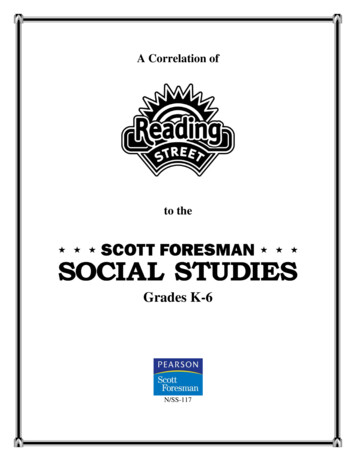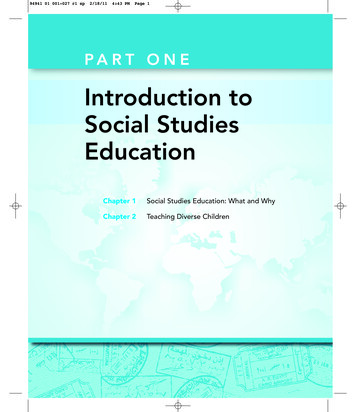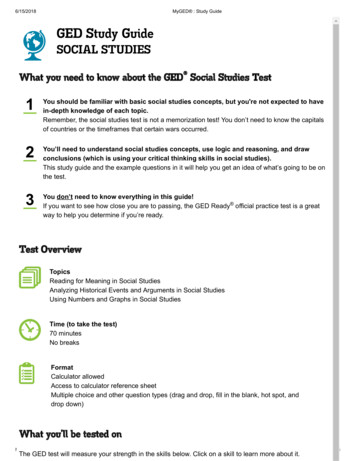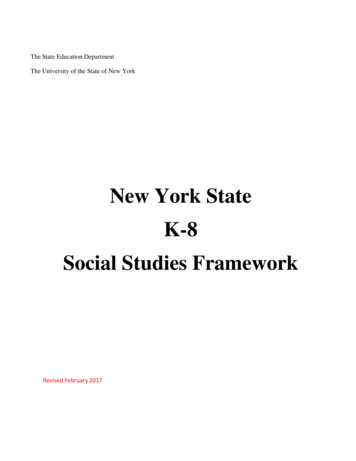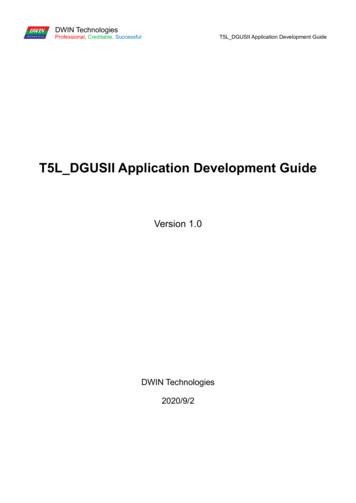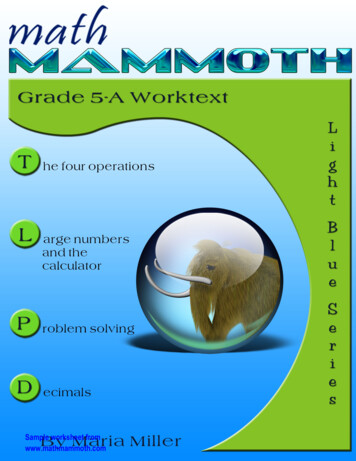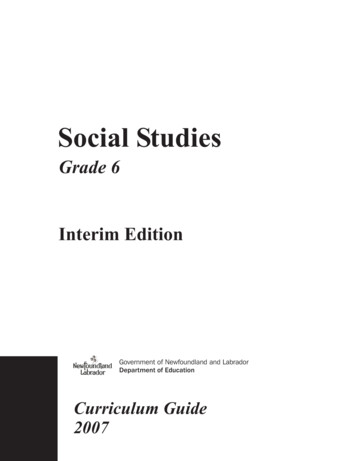
Transcription
Social StudiesGrade 6Interim EditionGovernment of Newfoundland and LabradorDepartment of EducationCurriculum Guide2007
ACKNOWLEDGMENTSAcknowledgmentsThe Departments of Education acknowledge the work done by social studies consultants and other educatorswho served on the regional social studies committee.New BrunswickKim EvansAvis FittonJohn HildebrandBev Loker-FrenchSandra MitchellNova ScotiaMary FedorchukBruce FisherRick MacDonaldMyles McCormickNewfoundland and LabradorDarryl FillierSmita JoshiVictor KendallPrince Edward IslandBethany DoironFrank HennesseyAllan MacRaeLaura NoyeThe Departments of Education also acknowledge the contribution of all the educators who served onprovincial writing teams and curriculum committees, and who reviewed or piloted the curriculum.GRADE 6 WORLD CULTURES – A CURRICULUM GUIDE1
ACKNOWLEDGEMENTS2GRADE 6 WORLD CULTURES – A CURRICULUM GUIDE
CONTENTSContentsIntroductionBackground . . . . . . . . . . . . . . . . . . . . . . . . . . . . . . . . . . . . . . . .Aims of Social Studies . . . . . . . . . . . . . . . . . . . . . . . . . . . . . . . .Purpose of Curriculum Guide . . . . . . . . . . . . . . . . . . . . . . . . . .Guiding Principles . . . . . . . . . . . . . . . . . . . . . . . . . . . . . . . . . . .1122Program Designand OutcomesOverview . . . . . . . . . . . . . . . . . . . . . . . . . . . . . . . . . . . . . . . . . .Essential Graduation Learnings (EGLs) . . . . . . . . . . . . . . . . . . .General Curriculum Outcomes (GCLs) . . . . . . . . . . . . . . . . . . .Processes . . . . . . . . . . . . . . . . . . . . . . . . . . . . . . . . . . . . . . . . . .Attitudes, Values, and Perspectives . . . . . . . . . . . . . . . . . . . . . . .34566Contexts forLearning andTeachingAdolescent Learners: Characteristics and Needs . . . . . . . . . . . . . 9Equity and Diversity . . . . . . . . . . . . . . . . . . . . . . . . . . . . . . . . 11Principles Underlying the Social Studies Curriculum . . . . . . . . 11The Social Studies Learning Environment . . . . . . . . . . . . . . . . 12Integration of Technology in Social Studies. . . . . . . . . . . . . . . . .15Assessing and Evaluating Student Learning . . . . . . . . . . . . . . . 18CurriculumOverviewKindergarten–9 Social Studies Program . . . . . . . . . . . . . . . . . .Grade 6: World Cultures . . . . . . . . . . . . . . . . . . . . . . . . . . . . .Grade 6: Specific Curriculum Outcomes . . . . . . . . . . . . . . . . .How to Use the Four-Column Curriculum Layout . . . . . . . . . .Grade 6: Year Overview . . . . . . . . . . . . . . . . . . . . . . . . . . . . . .Grade 6Curriculum212122263879Unit 4: Expressions of Culture . . . . . . . . . . . . . . . . . . . . . . . . 105Unit 5: World Issues . . . . . . . . . . . . . . . . . . . . . . . . . . . . . . . . 129Unit 6: Canada: Reflections on a Multicultural Mosaic . . . . . . 149AppendicesAppendix D:Appendix E:Appendix F:Appendix G:Appendix H:Appendix I:Appendix J:GRADE 6 WORLD CULTURES – A CURRICULUM GUIDEGraphic Organizers . . . . . . . . . . . . . . . . . . . . . 165Studying Local Culture . . . . . . . . . . . . . . . . . . 167Using Primary Sources in the Classroom . . . . . 171Examining Issues in a Study of World Cultures 175Student Response Journals . . . . . . . . . . . . . . . 177Portfolio Assessment . . . . . . . . . . . . . . . . . . . . 179Rubrics in Assessment . . . . . . . . . . . . . . . . . . . 183Rubrics for Writing, Reading/Viewing, Listening,Speaking, and Group Participation . . . . . . . . . 185iii
iv
INTRODUCTIONIntroductionBackgroundThe Atlantic Canada social studies curriculum was planned anddeveloped by regional committees whose deliberations were guidedby consideration of the learners and input from teachers. Theregional committees consisted of teachers, other educators, andconsultants with a diverse range of experiences and backgrounds ineducation. Each curriculum level was strongly influenced bycurrent social studies research as well as developmentallyappropriate pedagogy.Aims of SocialStudiesThe vision for the Atlantic Canada social studies curriculum is toenable and encourage students to examine issues, respond criticallyand creatively, and make informed decisions as individuals and ascitizens of Canada and of an increasingly interdependent world.An effective social studies curriculum prepares students to achieveall essential graduation learnings. In particular, social studies, morethan any other curriculum area, is vital in developing citizenship.Social studies embodies the main principles of democracy, such asfreedom, equality, human dignity, justice, rule of law, and civicrights and responsibilities. The social studies curriculum promotesstudents’ growth as individuals and citizens of Canada and anincreasingly interdependent world. It provides opportunities forstudents to explore multiple approaches that may be used to analyseand interpret their own world and the world of others. Socialstudies presents unique and particular ways for students to view theinterrelationships among Earth, its people, and its systems. Theknowledge, skills, and attitudes developed through the social studiescurriculum empower students to be informed, responsible citizensof Canada and the world, and to participate in the democraticprocess to improve society.In particular, the social studies curriculum integrates the concepts, processes, and ways of thinking drawnfrom the diverse disciplines of history and the social sciences,(including geography, economics, political science, sociology,and anthropology). It also draws from the humanities,literature, and the pure sciences provides the multidisciplinary lens through which studentsexamine issues affecting their lives from personal, provincial,national, academic, pluralistic, and global perspectivesGRADE 6 WORLD CULTURES - A CURRICULUM GUIDE1
INTRODUCTIONPurpose ofCurriculumGuideThe overall purpose of this curriculum guide is to advance social studieseducation and social studies teaching and learning, and, at the same time,recognize and validate effective practices that already exist in manyclassrooms.More specifically, this curriculum guide provides detailed curriculum outcomes to which educators and others canrefer when making decisions concerning learning experiences,instructional techniques, and assessment strategies in the grade 6 socialstudies program informs both educators and members of the general public about thephilosophy and scope of social studies education for the middle schoollevel in the Atlantic provinces promotes the effective learning and teaching of social studies for studentsenrolled in grade 6 classroomsGuidingPrinciples2All kindergarten to grade 9 curriculum and resources should reflect theprinciples, rationale, philosophy, and content of the Foundation for theAtlantic Canada Social Studies Curriculum (1999) by being meaningful, significant, challenging, active, integrative, and issuesbased being consistent with current research pertaining to how children learn incorporating multiple perspectives promoting the achievement of Essential Graduation Learnings (EGLs),General Curriculum Outcomes (GCOs), and Key-Stage CurriculumOutcomes (KSCOs) reflecting a balance of local, national, and global content promoting achievement of the processes of communication, inquiry, andparticipation promoting literacy through the social studies developing knowledge, skills, and attitudes for lifelong learning promoting the development of informed and active citizens contributing to the achievement of equity and supporting diversity supporting the realization of an effective learning environment promoting opportunities for cross-curricular connections promoting resource-based learning promoting the integration of technology in learning and teaching socialstudies promoting the use of diverse learning and assessment strategiesGRADE 6 WORLD CULTURES - A CURRICULUM GUIDE
PROGRAM DESIGN AND OUTCOMESProgram Design and OutcomesOverviewThis social studies curriculum is based on Foundation for theAtlantic Canada Social Studies Curriculum (1999). Specificcurriculum outcomes (SCOs) were developed to be congruent withkey-stage curriculum outcomes (KSCOs), general curriculumoutcomes (GCOs), and essential graduation learnings (EGLs). Inaddition, the processes of social studies, as well as the attitudes,values, and perspectives, are embedded in the SCOs.GRADE 6 WORLD CULTURES - A CURRICULUM GUIDE3
PROGRAM DESIGN AND OUTCOMESEssentialGraduationLearningsThe Atlantic provinces worked together to identify abilities andareas of knowledge considered essential for students graduatingfrom high school. These are referred to as essential graduationlearnings. Some examples of key-stage outcomes in social studieswhich help students move towards attainment of the essentialgraduation learnings are given below.Aesthetic ExpressionGraduates will be able to respond with critical awareness to variousforms of the arts and be able to express themselves through thearts.By the end of grade 6, students will be expected to describe how culture is preserved, modified, and transmittedCitizenshipGraduates will be able to assess social, cultural, economic andenvironmental interdependence in a local and global context.By the end of grade 6, students will be expected to describe the main features of the Canadian constitutionCommunicationGraduates will be able to use the listening, viewing, speaking,reading, and writing modes of language(s), as well as mathematicaland scientific concepts and symbols, to think, learn, andcommunicate effectively.By the end of grade 6, students will be expected to demonstrate an understanding of the concepts and vocabularyassociated with time, continuity, and changePersonal DevelopmentGraduates will be able to continue to learn and to pursue an active,healthy lifestyle.By the end of grade 6, students will be expected to explain why people’s incomes may change and the impact ofthat change on their lifestyleProblem SolvingGraduates will be able to use the strategies and processes needed tosolve a wide variety of problems, including those requiringlanguage, mathematical, and scientific concepts.By the end of grade 6, students will be expected to identify and explain how people, goods, and ideas move amongcommunitiesTechnologicalCompetenceGraduates will be able to use a variety of technologies, demonstratean understanding of technological applications, and applyappropriate technologies for solving problems.By the end of grade 6, students will be expected to identify and describe examples of positive and negativeinteractions among people, technology, and the environment4GRADE 6 WORLD CULTURES - A CURRICULUM GUIDE
PROGRAM DESIGN AND s)The general curriculum outcomes (GCOs) for the social studiescurriculum are organized around six conceptual strands. Thesegeneral curriculum outcomes statements identify what students areexpected to know and be able to do upon completion of study insocial studies. Specific social studies concepts are found within theconceptual strands (see Appendix A). Examples of key-stagecurriculum outcomes, by the end of grade 6, are given for eachgeneral curriculum outcome.Citizenship, Power, andGovernanceStudents will be expected to demonstrate an understanding of therights and responsibilities of citizenship, and the origins, functions,and sources of power, authority, and governance.By the end of grade 6, students will be expected to identify and explain the rights and responsibilities of individualcitizens in a local, national, and global context recognize how and why individuals and groups have differentperspectives on public issuesCulture and DiversityStudents will be expected to demonstrate an understanding ofculture, diversity, and world view, recognizing the similarities anddifferences reflected in various personal, cultural, racial, and ethnicperspectives.By the end of grade 6, students will be expected to explain why cultures meet human needs and wants in diverseways describe how perspectives influence the ways in whichexperiences are interpretedIndividuals, Societies,and Economic DecisionsStudents will be expected to demonstrate the ability to makeresponsible economic decisions as individuals and as members ofsociety.By the end of grade 6, students will be expected to give examples of various institutions that make up economicsystems explain how a government’s policies affect the living standardsof all its citizensInterdependenceStudents will be expected to demonstrate an understanding of theinterdependent relationship among individuals, societies, and theenvironment—locally, nationally, and globally—and theimplications for a sustainable future.By the end of grade 6, students will be expected to recognize and explain the interdependent nature of relationshipsamong individuals, societies, and the environment identify and describe examples of positive and negativeinteractions among people, technology, and the environmentGRADE 6 WORLD CULTURES - A CURRICULUM GUIDE5
PROGRAM DESIGN AND OUTCOMESPeople, Place, andEnvironmentStudents will be expected to demonstrate an understanding of theinteractions among people, places, and the environmentTime, Continuity, andChangeStudents will be expected to demonstrate an understanding of thepast and how it affects the present and the futureBy the end of grade 6, students will be expected to use maps, globes, pictures, models, and technology to representand describe physical and human systems describe examples of cause and effect, and change over timeBy the end of grade 6, students will be expected to identify trends that may shape the future research and describe historical events and ideas from differentperspectivesProcessesThe social studies curriculum consists of three major processes:communication, inquiry, and participation (see Appendix B for aProcess-Skills Matrix). The processes are reflected in the“Suggestions for Learning and Teaching” and the “Suggestions forAssessment” found in social studies curriculum guides. Theseprocesses constitute many skills—some of these skills areresponsibilities shared across curriculum areas, whereas others arecritical to social studies.CommunicationCommunication requires that students listen, read, interpret,translate, and express ideas and information.InquiryInquiry requires that students formulate and clarify questions,investigate problems, analyse relevant information, and developrational conclusions supported by evidence.ParticipationParticipation requires that students act both independently andcollaboratively in order to solve problems, make decisions, andnegotiate and enact plans for action in ways that respect and valuethe customs, beliefs, and practices of others.Attitudes, Values,and PerspectivesListed below are major attitudes, values, and perspectives in middleschool social studies that have been organized according to the sixconceptual strands and the three processes of the foundationdocument. Some attitudes, values, and perspectives are embeddedin more than one strand or process—this is consistent with theintegrative nature of social studies.By Conceptual StrandCitizenship, Power, and Governance appreciate the varying perspectives on the effects of power,privilege, and authority on Canadian citizens develop attitudes that balance rights with responsibilities value decision making that results in positive change6GRADE 6 WORLD CULTURES - A CURRICULUM GUIDE
PROGRAM DESIGN AND OUTCOMESCulture and Diversity recognize and respond in appropriate ways to stereotyping/discrimination appreciate that there are different world views appreciate the different approaches of cultures to meeting needsand wantsIndividuals, Societies and Economic Decisions appreciate the wide range of economic decisions that individualsmake, and their effects recognize the varying impacts of economic decisions onindividuals and groups recognize the role that economics plays in empowerment anddisempowermentInterdependence appreciate and value the struggle to attain universal humanrights recognize the varying perspectives on the interdependenceamong society, the economy, and the environment appreciate the impact of technological change on individuals andsocietyPeople, Place, and the Environment appreciate the varying perspectives of regions value maps, globes, and other geographic representations asvaluable sources of information and learning appreciate the relationship between attributes of place andcultural valuesTime, Continuity, and Change value society’s heritage appreciate that there are varying perspectives on a historicalissue recognize the contribution of the past to present-day societyBy ProcessCommunication read critically respect other points of view use various forms of group and interpersonal communicationInquiry recognize that there are various perspectives in the area ofinquiry recognize bias in others and in themselves appreciate the value of critical and creative thinkingParticipation take responsibility for individual and group work respond to class, school, community, or national public issues value the importance of taking action to support responsiblecitizenshipGRADE 6 WORLD CULTURES - A CURRICULUM GUIDE7
PROGRAM DESIGN AND OUTCOMES8GRADE 6 WORLD CULTURES - A CURRICULUM GUIDE
CONTEXTS FOR LEARNING AND TEACHINGContexts for Learning and TeachingAdolescentLearners:Characteristicsand NeedsThe adolescent years between the ages of 10 and 14 represent thedevelopmental stage that leads to maturity or adulthood. Becauseeducators have an important role in helping young people preparefor the adult world, they need to know and appreciate adolescentcharacteristics and their application to learning.During the middle years, the adolescent learner experiences rapidand significant change with respect to physical, emotional, social,intellectual, and moral development. These changes are oftenintense and varied and, therefore, need to be acknowledged bythose who direct and foster adolescents’ development and learning.While some general characteristics for adolescents have beenidentified, it should be recognized that these characteristics vary ateach grade and age. Each adolescent is a unique individual and anyattempt to classify must be regarded as extremely general.Nonetheless, the following scheme highlights for the educatorsome characteristics of young adolescents and outlines theirimplications for learning.Physical DevelopmentAdolescent development is marked by accelerated and variablegrowth rates. Strength, energy levels, stamina, and sexual maturityof boys and girls occur at different times and rates. Physicalchanges alter the way young adolescents perceive themselves, butthese perceptions differ for boys and girls. The acceleration ofgrowth and related physical changes make demands on the energiesof early adolescents. In learning how to adjust to their “new body,”they experience periods of over-activity and listlessness—atendency that overtires them until they learn to moderate theiractivity.Early adolescents need experiences and opportunities that helpthem understand their own physical development. School shouldprovide opportunities for constructive social interaction, andestablish a healthy, stable classroom environment. To channel theirenergy, young adolescents require a variety of physical activities thatstress skill improvement and accommodate differences in size,weight, strength, and endurance. Because of the wide ranges inphysical development between boys and girls, what is taught andhow it is taught should reflect the range of needs and interests ofstudents.Social DevelopmentYoung adolescents are searching for greater autonomy as theyattempt to define themselves independent of the family unit. Asthey become more socially interactive, many engage in risk-takingbehaviours, family allegiance diminishes, and peer relationships takeon increased importance. Conformity to the dress, speech, andbehaviour of their peer group is quite common. They appear toGRADE 6 WORLD CULTURES - A CURRICULUM GUIDE9
CONTEXTS FOR LEARNING AND TEACHINGfluctuate between a demand for independence and a desire forguidance and direction. At this time authority still remainsprimarily with the family, but the adolescent will exercise the rightto question or reject suggestions from adults.Parental involvement in the lives of young adolescents is still crucialand should be encouraged. There is a need for many positive socialinteractions with peers and adults. Young adolescents benefit fromopportunities to work with peers in collaborative and small-grouplearning activities, since a tremendous amount of their learningoccurs in a social context. Yet, they require structure and clearlimits as well as opportunities for setting standards for behaviourand establishing realistic goals. Activities such as role-playing andsociodramas allow them to explore ways of dealing with varioussituations that may arise.Emotional DevelopmentYoung adolescents display widely different and often conflictingemotions. Their moods, temperaments, and behaviours areprofound and intense. They seem to change from one moment tothe next, they are often unpredictable, and their feelings tend toshift between superiority and inferiority. Appraisals of self areoften overly critical and negative as they frequently makecomparisons and see themselves deficient in many ways. This agegroup is extremely sensitive to criticism of any kind and is easilyoffended. Feelings of inadequacy, coupled with fear of rejection bytheir peer group, contribute to low self-esteem. Adolescents seetheir problems as unique and they often exaggerate simpleoccurrences.To develop emotional confidence, adolescents need opportunitiesthat allow them to release emotional stress and develop decisionmaking skills. Learning activities should be designed to enhanceself-esteem, to recognize student accomplishments, and toencourage the development of positive attitudes. Youngadolescents need opportunities to test their strengths andweaknesses as they explore issues that are of concern to them.Intellectual DevelopmentIntellectual development varies tremendously among earlyadolescents. While some are learning to handle more abstract andhypothetical concepts and to apply problem-solving approaches tocomplex issues, a great many are still in the stage of concreteoperations. Adolescents have a present focus as opposed to afuture orientation. During this stage they retain a certainegocentrism, which leads them to believe that they are unique,special, even invulnerable to harm. Adolescents may be unaware ofthe consequences of risk-taking behaviour. As their ability toprocess and relate information increases, there is atendency to search for an understanding of rules and conventionsand to question the relevance of what is taught.Young adolescents need opportunities to develop their formalthinking skills and strategies if they are to move from concrete toabstract thinking. To develop the skills of critical analysis and10GRADE 6 WORLD CULTURES - A CURRICULUM GUIDE
CONTEXTS FOR LEARNING AND TEACHINGdecision making, young adolescents should be exposed toexperiential learning where they can apply skills to solve real-lifeproblems, and question and analyse significant issues.Equity andDiversityThe Atlantic Canada social studies curriculum is designed to meetthe needs and interests of all students. The curriculum shouldprovide for the inclusion of the interests, values, experiences, andlanguage of each student and of the many groups within our local,regional, national, and global communities.The society of Atlantic Canada, like all of Canada, reflects adiversity of race, ethnicity, gender, ability, values, lifestyles, andlanguages. Schools should foster the understanding of suchdiversity. Social studies curriculum promotes a commitment toequity by valuing, appreciating, and accepting the diverse andmulticultural nature of our society, as well as by fostering awarenessand critical analysis of individual and systemic discrimination.In a school setting characterized by mutual trust, acceptance, andrespect, student diversity is both recognized and valued. Allstudents are entitled to be respected and valued and, in turn, areresponsible for respecting and valuing all other people. They areentitled to an educational system that affirms their gender, racial,ethnic, and cultural identity, and promotes the development of apositive self-image. Educators should ensure that classroompractices and resources positively and accurately reflect diverseperspectives, and reject prejudiced attitudes and discriminatorybehaviours.PrinciplesUnderlying theSocial StudiesCurriculumEmpowering and effective social studies is meaningful, significant,challenging, active, integrative, and issues-based. Meaningful social studies encourages students to learn throughpurposeful experiences designed around stimulating ideas, socialissues, and themes, and discourages the memorization ofdisconnected pieces of information. Significant social studies is student-centred and age-appropriate.Superficial coverage of topics is replaced by emphasis on thetruly significant events, concepts, and principles that studentsneed to know and be able to apply in their lives. Challenging social studies involves teachers modelling highexpectations for their students and themselves, promoting athoughtful approach to inquiry, and demanding well reasonedarguments. Active social studies encourages students to assume increasingresponsibility for managing their own learning. Exploration,investigation, critical and creative thinking, problem solving,discussion and debate, decision making, and reflection areessential elements of this principle. This active process ofconstructing meaning encourages lifelong learning.GRADE 6 WORLD CULTURES - A CURRICULUM GUIDE11
CONTEXTS FOR LEARNING AND TEACHING Integrative social studies crosses disciplinary borders to exploreissues and events, while using and reinforcing informational,technological, and application skills. This approach facilitates thestudy of the physical and cultural environment by makingappropriate, meaningful, and evident connections to the humandisciplines and to the concepts of time, space, continuity, andchange. Issues-based social studies considers the ethical dimensions ofissues, and addresses controversial topics. It encouragesconsideration of opposing points of view, respect for wellsupported positions, sensitivity to cultural similarities anddifferences, and a commitment to social responsibility andaction.The Social StudiesLearningEnvironmentThe Effective Social StudiesClassroomWith the accelerating pace and scope of change, today’s studentscannot prepare for life by merely learning isolated facts. Problemsolving, critical and creative thinking, and informed decision makingare essential for success in the future. The social studies learningenvironment can contribute significantly to the development ofthese critical attributes.An effective instructional environment incorporates principles andstrategies that recognize and accommodate varied learning styles,multiple intelligences, and abilities that students bring to theclassroom. Teaching approaches and strategies foster a wide varietyof experiences to actively engage all students in the learning process.The nature and scope of social studies provide unique opportunitiesto do this.To meet these challenges, the social studies program reflects a widerange of elements.Respectful of diversityStudents come to the classroom from backgrounds that representthe reality of Canada’s diversity, whether it is in terms of socialidentity, economic context, race/ethnicity, or gender. The socialstudies learning environment attempts to affirm the positive aspectsof this diversity, and foster an understanding and appreciation of themultiple perspectives that this diversity can lend to the classroom.Regardless of diversity in their backgrounds, students should begiven equal access to educational opportunities, and can besuccessful at them.12GRADE 6 WORLD CULTURES - A CURRICULUM GUIDE
CONTEXTS FOR LEARNING AND TEACHINGInclusive and invitingThe social studies classroom should be a psychologically safe placein which to learn. It should be free from bias and unfair practicesthat may arise from perceptions related to ability, race, ethnicity,culture, gender, or socioeconomic status. Students come withdifferent attitudes, levels of knowledge, and points of view, but thesedifferences should not be obstacles, but opportunities to rise abovestereotypes and to develop positive self-images. Students should beprovided collaborative learning contexts through which they canbecome aware of, and transcend, their own stereotypical attitudesand behaviours.Engaging and interactiveIf classrooms are to be places where there is respect for diversityand where learning is engaging and interactive, students will beexpected to participate in inquiry and problem-solving situations.Students will be provided with direct and vicarious experiences towhich they can apply social studies skills, strategies, and processesfor purposeful ends. Rather than assume a passive role, studentswill bring their critical faculties to information and knowledge toshape them into meaningful patterns.Relevant and significantSince the intermediate learner is naturally critical of what the adultworld represents, it is necessary for the social studies curriculum tobe convincing and relevant. Consequently, it must provide learningsituations that incorporate student interests, but also encouragestudents to question their knowledge, their assumptions, and theirattitudes. In so doing, they will come to understand and appreciatetheir own heritage and culture at a deeper level. Past history andcontemporary studies play a key role si
culture, diversity, and world view, recognizing the similarities and differences reflected in various personal, cultural, racial, and ethnic perspectives. By the end of grade 6, students will be expected to explain why cultures meet human needs and wants in diverse way


